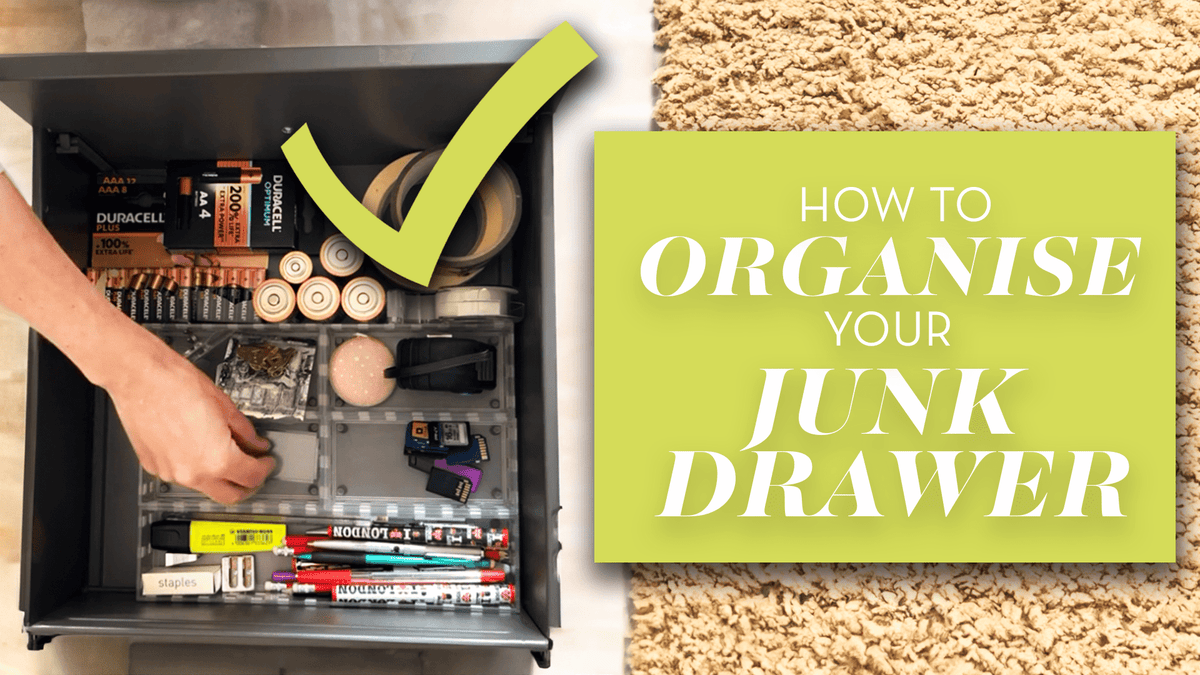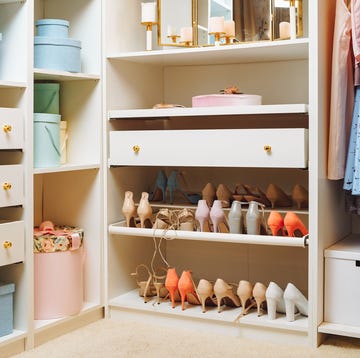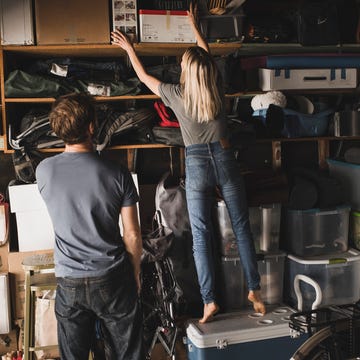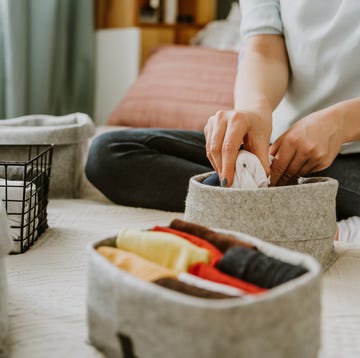‘There are books everywhere! They’re stacked up in every corner – even lining my corridors!’ This is a common problem, so I wasn’t surprised when one of my colleagues confessed this to me during a morning meeting. Reading is something we do daily; but unless you opt for e-books, hard copies can quickly take over the home, stacking up every which way you look.
Decluttering your books will likely involve making some tough decisions, especially where there are sentimental items or unread books involved. To help, I spoke to three professional organisers to pull together the ultimate guide to decluttering your books, so you can limit your reading pile to the shelves.
1. Make a plan
Before you start pulling everything out, consider what you want to achieve from this declutter and how you want it to look once you’re finished. Do you want every book to fit on your shelf or are you happy to leave a few rogue books out to decorate your home? Perhaps you’ll want to move some of your collection elsewhere, and need to make space beforehand. To prepare yourself, estimate how many books you’ll need to declutter to reach your goal.
Also think about whether you want to do this task all at once, or work through your books shelf-by-shelf. Depending on the number of books you’re sorting through and how much time you have, it may be best to break up the work. According to Lynda Wylie, professional organiser from Tidy Rooms: ‘As with any decluttering project, start small. Break down your bigger goal into smaller manageable steps. If your entire book collection needs rationalising, begin with one shelf, or one author, one genre or one handful. Set limits to help you declutter – eg, I will review two shelves; I will review books for 30 minutes.’
2. Sort through your books
Start by removing all the books from your selected space and categorising them. Create one pile for fiction, another for non-fiction, one for study books and notebooks and one for sentimental books, and so on.
Helen Sanderson, The Clutter Therapist and author of The Secret Life Of Clutter, says: ‘There is something about holding a book in your hands as opposed to looking at the spine on a shelf that helps you see the collection afresh and make decisions – it can bring a sense of momentum, and remove some dust! Sort your books into three broad categories: keep, donate, and don’t know. If you’re part-way through the culling, you can turn round the books you’ve been through, making it easy to see where you are when you return to the job.’
It's best to work your way through categories by ease of decluttering. Start with those you find it easiest to make decisions about, such as old study books and previously read books, and gradually work your way through them by difficulty, saving sentimental books for last. By doing this, you’ll become more used to the decision-making process.
3. Make decisions
If you’re stuck on what to do with a book, ask yourself: ‘When did I last read it; does it inspire any emotion; will I likely read it again; would someone I know want to read it?’ Such questions can give you a better insight into what the book really means to you.
Lynda also suggests asking yourself the following questions: ‘What am I keeping this book for; can I pinpoint what might be stopping me from letting it go; would it feel easier to let go if I knew where the book was going?’
If you struggle to declutter, finding the root of what’s stopping you can help you to overcome this. It can also help to have another person there, to help realign your values and give you an outside perspective.
Here are some handy tips for decluttering different types of books:
Magazines
My father once hid his magazines under the towels in the bathroom, all so that my mother wouldn’t find them. And it worked, until the towels started to magically elevate from the growing stack. While we often want to hang on to our magazines, these can quickly mount up as new ones come in.
Helen continues: ‘Magazines often contain a sense of “I might need this later”. But if you haven’t referred back to them in months (or years), remind yourself it’s safe to let them go. Consider taking photos of inspiring pages, or scrapbooking them before recycling. And beware of sitting and reading when you’re meant to be decluttering.’
Unread books
Unread books are some of the trickiest to let go of. It feels like a waste of money; as if the book hasn’t served its purpose.
For any unread books you’re determined to keep and read, Lynda suggests ‘placing unread books close to the physical place where you tend to read – make them easily accessible. And give yourself a deadline.’
However, Emma Kenwrick-Meehan, professional organiser from Home, Nip & Tuck, believes that unread books can lead to postponed decisions. She suggests, ‘If you haven’t read it in over a year, be honest, are you really going to? Let it go to someone who will read it. Your home isn’t meant to store guilt. Pick your top 5-10 unread books and keep them somewhere visible. If you don’t read them in the next few months, they’re probably not meant to stay.’
Sentimental books
Books that hold an emotional attachment are the hardest to declutter. I have a few cookbooks that my nan once gave to me that I’ll never let go of. I don’t use them at all – I keep them solely for their sentimental value. But, when you have an abundance of sentimental books, you’ll need to address their true worth.
Helen suggests moving them into a ‘memory pile. Give yourself time to reflect on whether they are still needed in your life and notice what it brings up. Is it truly about the book – or the person or memory attached to it? Find ways to honour the feelings without keeping the item, maybe by journalling, taking a photo or writing a few lines about why it mattered, this can help you say goodbye without grief.’
Lynda, on the other hand, says: ‘You may not be ready to let go of your sentimental books – ones with inscriptions, of high value or those with special meaning. When you are ready, you may like to photograph them before letting them go or find a specific person or organisation to pass them on to. For now, you might need them to reside on your shelf, jogging your memories and that’s ok.’
Asking another person to help can make a difference when sorting through sentimental items. If you organise your sentimental pile by what means the most to you, it can help you to see what has the greatest value; after which, you can address the rest. However, you should never declutter anything you’re uncomfortable letting go of.
4. How to remove your books
Move the books you’ve decided to declutter out of the way, but avoid churning (the act of moving things around without making a final decision) and place them somewhere they can’t be ignored. You’ve got a few options with these books; you can donate, sell or recycle them.
However, it can be tricky to find a charity shop that will accept large book donations nowadays. Lynda agrees: ‘Some charity shops no longer take books and some are unable to take big hardback/coffee-table style books. Check with the shop first before you turn up with bags of books and are turned away. Specialist books can sometimes go via specialist charity organisations, such as Books2Africa UK and Book Aid.’
Emma adds: ‘Drop books off at local community shelves, schools or waiting rooms. Knowing they’ll be enjoyed again makes it so much easier to part with them.’
Books can also be sold, although their value will vary widely. You can use an app like Sell Your Books to scan the barcodes and get a quick offer.
5. Replace your books
Only replace your books when you’ve made a final decision on all of them, so you’re not encouraged to store more than you need based on the remaining space! Before you replace your books, give the bookshelf a much-needed clean with a microfibre cloth to pick up the dust.
Organise your books in such a way that you can easily find what you need. Categorise by type and, for bookcases, keep the heavier hardbacks towards the bottom shelves to keep it weighted. And bear in mind that storing books in sunlight will bleach the covers.



















